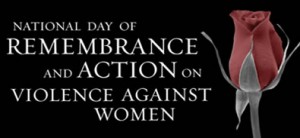By Robert Washburn
 Each year a group of people gather near a sculpture on the east side of Church Street in Victoria Park on Dec. 6 at noon to remember women and children who are victim’s of violence.
Each year a group of people gather near a sculpture on the east side of Church Street in Victoria Park on Dec. 6 at noon to remember women and children who are victim’s of violence.
Every year in Canada, an estimated 382,000 children witness or experience family violence, according to a report done by the United Nations in 2006. On average, every six days a woman in Canada is killed by her intimate partner. Between January and August 2012, 25 women in Canada were murdered by a partner, according to Cornerstone, Northumberland’s family violence prevention centre.
While most times, this kind of violence happens behind closed doors, it occasionally takes places in very high-profile incidents.
This was the case late last week when NFL football fans learned Kansas City Chiefs linebacker Jovan Belcher shot his girlfriend and then drove to the team’s practice facility nearby where he shot himself in the parking lot while his coach and general manager watched. A three-month old child is now without parents.
Certainly, this is tragic on many levels. But it is also expensive. It costs the Canadian economy $6.9 billion annually. A recent study done by the University of British Columbia added up all the cost associated with health, legal and social services used by women who leave an abusive partner. This is not just government-funded programs, but also includes private sector money.
This year a different face was put to the issue during the Shafia trial in Kingston last spring. Mohammad Shafia, 58 and his wife Tooba Yahya, 42 and their son Hamed, 21, were each found guilty on four counts of first-degree murder in the killing of Shafia’s first wife and three daughters. It was a groundbreaking verdict as the case focused on an “honour killing”.
These are carried out as a way of cleansing a family name and restoring honour after a woman has behaved in deference to a cultural tradition. In Western culture, abuse stems from psychological dysfunction around intimate relationships and is considered a crime by the community. But culturally driven violence is more frequent in those societies, coming from approved codes around family, usually condoned by the group and the community, in some cases.
As a multicultural society, Canadian faces a growing complexity of issues around abuse of women. The federal government announced last week it is creating a national action plan to combat human trafficking. It is looking for proposals from various women’s organizations across the country to fund programs to reach out to women and girls brought to Canada as victims of human trafficking for cheap labour, prostitution and other forms of exploitation.
This is part of a larger initiative to promote the prevention of violence against women in high-risk neighbourhoods, engaging men and boys in ending violence against women; Ottawa has spent about $54 million in prevention programs.
But, it impossible to believe it is ever enough.
When there are 84 women and 45 children who used the local shelter and more than 1,500 people called the crisis line run by Cornerstones in 2011-2012, it is hard to believe things are going well. Those numbers have barely changes since 2010 with the same number of women being served, but slightly fewer children. There were more than 1,900 calls to the crisis line.
It is those women, children and others who will be remembered on Thursday during the ceremony, along with those who lost their lives. And while we will mourn the deaths, we can rededicate ourselves as a community to helping these victims.



Mr. Day is correct in his point regarding the dangers of being vague. People might wrongly assume it was a veiled reference and that is not what was intended. Let’s hope the overall argument is not severely damaged. Thanks.
“. . . after a woman has behaved in deference to a cultural tradition.” That would be ” in defiance of,” I assume.
I’m not at all comfortable with the words “cultural tradition” here. In some cases you are looking at a tribal tradition, or even a community tradition. In others, an aberrant group. Attributing such extreme actions to an entire culture does not seem defensible, unless you can show widespread adherance to such a “tradition” which would not be the case in the Shafia murders. Furthermore, if you don’t identify the “culture” to which you refer, careless readers might wrongly assume you mean “Muslims.” I suggest this whole “cultural tradition” language needs serious examination.